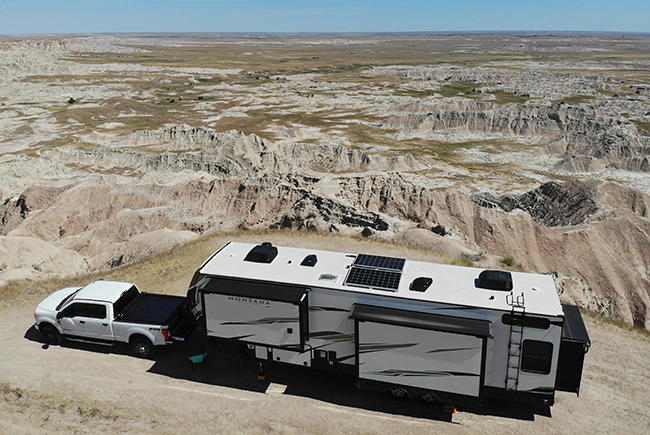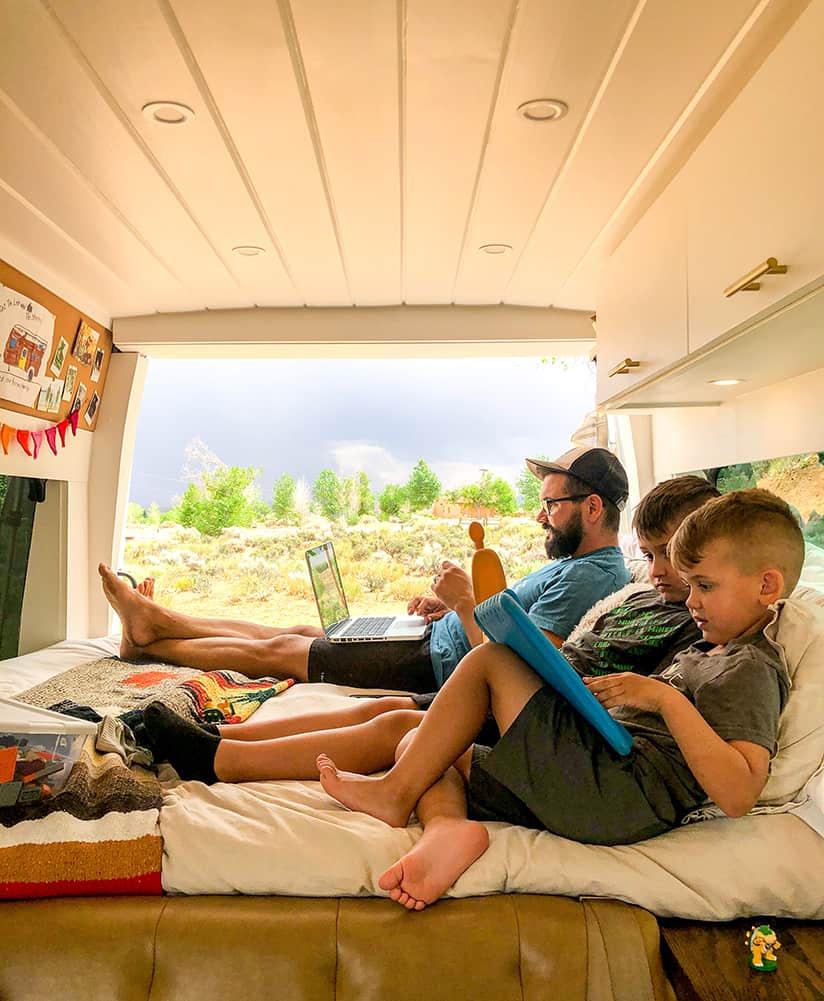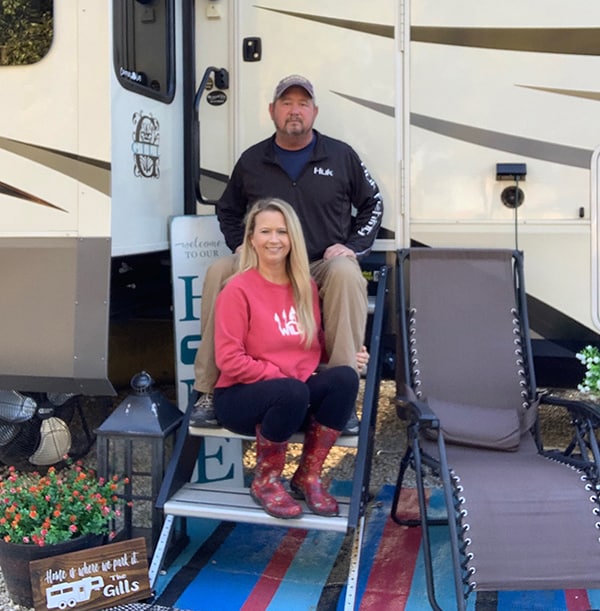Beginner RV Solar Solutions Guide: How Much Solar Power Do You Need?
Do you want to boondock off-grid or stay in beautiful dry campgrounds? Remote camping is why RV owners are increasingly seeking RV solar solutions. RV solar systems outperform generators for sustainability, noise reduction, and long-term costs.
However, choosing the best RV solar solutions for your RV lifestyle is daunting. You may wonder: How much solar power do I need for my RV? Is RV solar expensive? Can I wire and install an RV solar system by myself? Is an RV solar system worth it?
We consulted with experts at Future Solutions and the National RV Training Academy to get these answers and compile this complete beginner’s guide to RV solar solutions.
A print version of this article originally appeared in the May/June 2020 issue of Rootless Living magazine. This digital version has edits and additions.
RV Solar Solutions Explained
RV solar systems sound simple enough: solar panels catch the rays from the sun. The RV solar panels convert the rays into electricity. The electricity goes into your RV batteries, and you run your RV off of the batteries.
However, there are no one-size-fits-all best RV solar solutions. To find your best RV solar system, you need to answer the question, “Well, what is it you want to run?”
This question is where the confusion sets in and equations enter the picture. The best RV solar solutions are different for everyone. Just as your RV setup, travel, and priorities are unique from your neighbor’s, so are your RV power needs.
To get started, we’ll walk you through the components all RV solar solutions require. Then, we’ll explain how much power you require for your RV lifestyle.
There are four essential components to an RV solar system: solar panels, a solar controller, batteries, and an inverter.
RV Solar Panels
The solar panels capture the light from the sun and convert it into 12-volt DC (Direct Current) electricity. A solar panel can range anywhere from 80-300 watts, with most RV solar panels falling into the 160-200 watt range.
The two main types of RV solar panel cells are monocrystalline and polycrystalline. Monocrystalline panels use cells formed from a single silicon source (mono). Polycrystalline panels use cells formed from multiple sources of silicon (poly). Poly panels lose some efficiency, but not much, and are generally less expensive.
A wide range of RV solar panels on the market cater to different levels of quality, size, weight, and installation type. You can also utilize any kind of solar panel; it doesn’t have to be specifically designed and marketed for RVs.

RV Solar Controller
From there, an RV solar controller controls how many amps are being sent to your batteries to recharge.
The amount of power being taken in by your RV solar panels depends on what we call “sun strike.” How much, or little, sun strikes your panels determines how much electricity is created and sent to your batteries. Think of it like how the sun gives your skin a tan some days, and on others, you sunburn quickly.
RV solar panel sun strike depends on the cloud cover, trees, time of day, or where you are in the world. These factors impact the sunlight and amount of electricity your solar panels create.
Now, your RV batteries can only take in a limited amount of electricity at a time. For example, at noon on a perfect day, your RV solar panels could convert energy at an input level too high for the batteries. This scenario is where an RV solar controller comes in. The controller regulates how much electricity is sent to the batteries and ensures they never receive more electricity than they can handle.
A solar controller also works in reverse. In addition to controlling the energy flow into the batteries, it also prevents energy from being lost back through the panels when light is not present. There are two types of solar controllers, MPPT (Maximum Power Point Tracking) and PWM (Pulse Width Modulation). They operate differently, but both regulate energy for optimum charge and prevent battery back feed to the panels.
RV Batteries
There are two main types of RV batteries for RV solar solutions: lithium and AGM (Absorbent Glass Mat). The best RV battery depends on your budget, carrying capacity, and power needs.
The pros at Future Solutions created the below RV battery comparison chart to help you choose the best RV battery type for you.
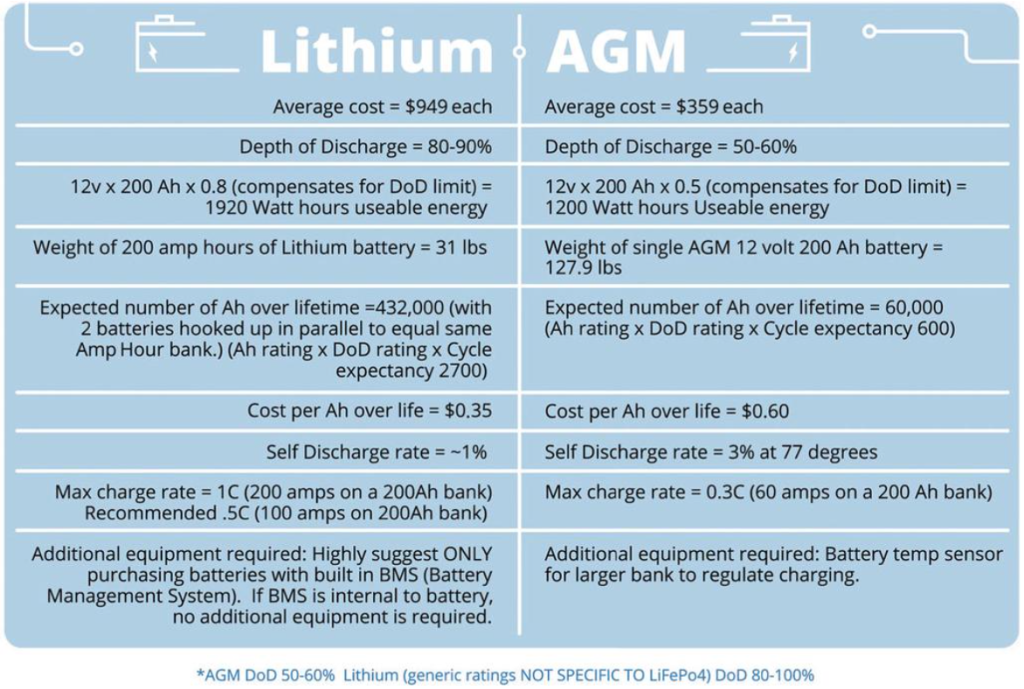
Lithium RV batteries are more expensive but lighter and more efficient. Full-time RVers and long-term boondockers usually opt for lithium. However, AGM RV batteries might be sufficient for part-time and weekend RVers and provide cost savings.
It’s important to note that you are not powering appliances with your solar panels. You’re powering devices and appliances with your batteries. Your solar panels are simply recharging the batteries, which will drain as you use their power for devices. You can have a large solar panel array and a large watt inverter, but the extra panels and watts are useless if you don’t have the batteries to store all the power.
RV Power Inverter
Your batteries are now receiving all that nice clean power from the sun, but it’s 12-volt DC electricity. Most appliances and electrical outlets run on 120 volts of AC (Alternating Current) electricity.
To run your appliances, you need an inverter to convert the battery’s 12-volt DC power into 120-volt AC power. This electricity created from your inverter is what you’re using to power your electronics in the RV.
How Much Solar Power Do I Need For My RV?
The answer to the question, “how much solar power do I need for my RV?” depends on which appliances and devices you use and how often. Everything uses a different amount of watts. Here is a chart of some typical devices used by RVers and the number of watts they require:
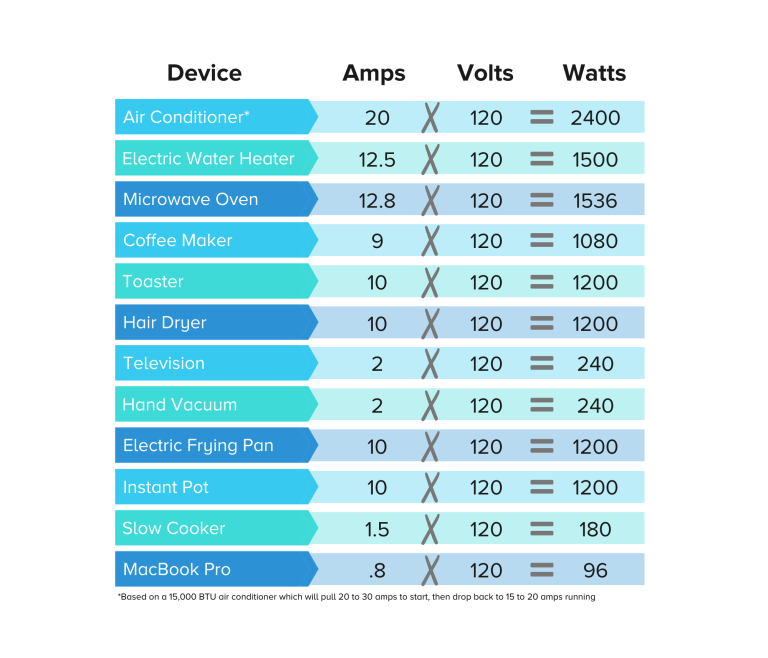
If you have an appliance that’s not listed here, it’s fairly easy to check its watts either on the product itself or through a quick google search.
Which of these do you use during a typical day in your RV life? How long do you run these? Will you use these while boondocking or only while connected to shore power?
Add up all the watts necessary for your lifestyle. That will be your starting point for how much solar power you need for your RV.
There are also devices in your RV that run directly from your 12-volt batteries. LED lights, carbon monoxide and propane detectors, water pumps, slide-outs, and leveling systems are examples of some 12-volt devices that use power. You will need to consider these devices for your overall battery bank.
Calculating Usable Watts From an RV Solar System
Now that you have an idea of your RV lifestyle’s total wattage, it’s time to do some math to calculate how much solar power you need for your RV.
Watts are the unit of measurement for electricity. Solar panels create DC electricity in watts. The solar controller regulates that energy and sends it to the batteries in volts and charges the battery in amps. The inverter is now “inventing” AC electricity for you in volts. However, you want to compare amps to the number of watts you need for your devices.
The simple formula is
Volts x Amps = Watts
Batteries rate electricity by amp hours. In other words, how many amps can you run for how many hours before you drain the battery? Since we calculate electricity in watts, it’s easiest to understand the battery’s watt-hours.
For example, let’s say your RV has one 100 amp-hours lithium battery. Lithium has a depth of discharge of about 80%, so we are taking the battery’s 12-volt electricity x 100 amps x .8 to compensate for the 80% and get 960 watts of usable energy. The more batteries you add to your setup, the more watt hours you have available.
Example: 100 amp hour lithium battery
12 volts X 100 amps X 0.8 of available battery
= 960 watts of usable solar power energy for your RV
Let’s go back to our chart of devices. A standard television uses approximately 240 watts/hour, so, with our lithium battery example above, you could watch about 4 hours of TV until it drains the battery.
Recharging Your Battery With RV Solar Power
This is where your solar panels come in. If you recharge your batteries with 1000 watts of power per hour, your batteries may never drain. However, that would only occur with a perfect sun strike, 24 hours a day, and that doesn’t even happen in Alaska during the summer.
In the best-case scenario, you would get about 5 hours of max solar power from your RV solar panels daily.
The more RV solar panel watts you have, the faster you can charge your battery. But as you can see from the example above, the answer to the question “how much solar power do I need for my RV?” is mainly determined by how many amp hours of batteries you have to store the power.
How Much Solar Power Do I Need For My RV Microwave?
Here’s the calculation for how much RV solar power you will need to power a standard RV microwave:
12.8 amps X 120 volts = 1536 watts
Using the example of a 100 amp hour lithium battery:
(100 amp hours * 80% depth of discharge) / 1536 watts
= 0.052 hours
You can run your microwave for about 30 minutes before you drain your 100 amp hour battery.
How to Calculate Solar Power Requirements For An RV Air Conditioner
Here’s the calculation for how much RV solar power you will need to power a 15,000 BTU RV air conditioner:
20 amps X 120 volts = 2400 watts
Using the example of a 100 amp hour lithium battery:
(100 amp hours * 80% depth of discharge) / 2400 watts
= 0.033 hours
You can run your air conditioner for about 15 minutes before you drain your 100 amp hour battery.
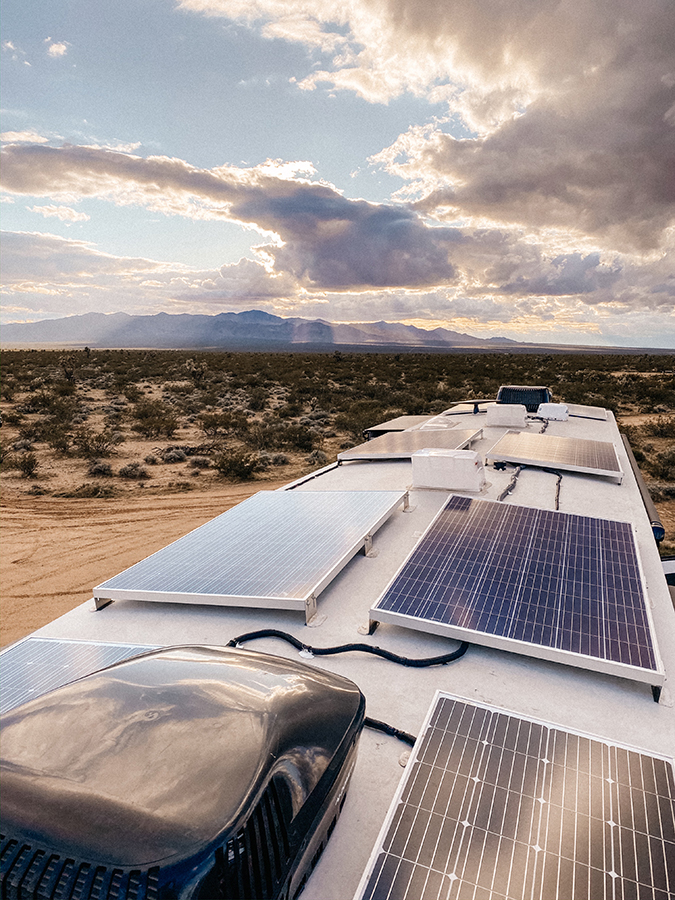
Factors For Buying the Best RV Solar Solutions
Here are a few more considerations when choosing your best RV solar system:
Adding to Your RV Solar System Later
You can always start small and add batteries and solar panels as needed. If you have plans to go bigger eventually, you might want to buy a larger inverter to accommodate your plans. The inverter is the one setup component that cannot have additions.
If you have a 1000-watt inverter, you can power 1000 watts. The type of inverter you choose will also dictate which types of loads you can run. A smaller high-frequency inverter cannot handle a device that needs a significant spike of power to start. However, if necessary, you can replace your inverter as you grow your system.
RV Solar Solutions Compatible With Your RV Weight
Be aware of your RV weight capacity. Unlike in a stationary home, the weight of a bunch of heavy batteries and panels will start to add up quickly.
While AGM batteries are cheaper, they weigh about 100 pounds each. A plus to lithium batteries is they weigh about 30 pounds each.
When adding panels to your roof, you need to leave room to service your roof and its existing appliances like vents and air conditioners.

The Difficulty of RV Solar Installation
Smaller RV solar solutions require less installation if any. You could power a small electricity need with a 1000-watt inverter, solar suitcase, extension cords, and one or two batteries.
You can also mount just a few panels to your roof, use a minor system with an extension cord, and plug your devices into a power strip.
Larger inverter systems require more in-depth installation. These RV solar systems need larger wire sizes and some re-wiring to power the entire breaker box rather than a specific inverted circuit.
Start Building Your RV Solar Solutions
RV solar solutions can be confusing, but the first step is calculating how much power you need for your RV. Once you have that number, a few equations can help you understand what you need for your RV lifestyle. The beauty of RV solar systems is their ability to scale, so if money is tight, you can start small and add later.
If you want to explore RV solar further, subscribe to Rootless Living magazine. We feature articles on RV solar components and stories of real installs. Check the May/June 2020 issue for additional RV solar system information and features. All subscriptions include access to digital back issues.
Solar Q & A
Rootless Living, Jan/Feb 2021
Quality Solar Panels
Rootless Living Jul/Aug 2020
RV Solar Solutions Experts
Nikki Kirk
The print version of this article appeared in the May/June 2020 issue of Rootless Living magazine. Nikki Kirk, Chief Editor of Rootless Living, wrote the original version of this article.
Future Solutions
Future Solutions and their Engineering team provided significant help in writing this piece and provided these diagrams. Future Solutions specializes in custom off-grid RV solar solutions specific to solar & advanced energy systems. They offer onsite installations in Elkhart, IN, and D-I-Y kits they will ship directly to you. If you’re ordering a new RV, they even provide dealer programs to install the system at their facility between factory build and dealer pick-up.
If you’d like Future Solutions to design an RV solar system specific to your RV lifestyle, send them a message on their website at fsi-solutions.com and follow them on Instagram @fsi.solutions and Facebook @FutureSolutionsInc.
National RV Training Academy
Todd Henson of the National RV Training Academy walked the Rootless team through all the solar components in his training facility in Athens, TX. If you are an RVer or looking to purchase an RV, the National RV Training Academy offers both online or in-person “Basic RV Maintenance Training Course.” This week-long course will teach you how to fix 80% of the things that could go wrong in your RV, saving you money on repairs, and help you identify issues to look for when buying an RV. For more on the courses, check out NRVTA.com
Source: https://rootlessliving.com/rv-solar-solutions-guide/

